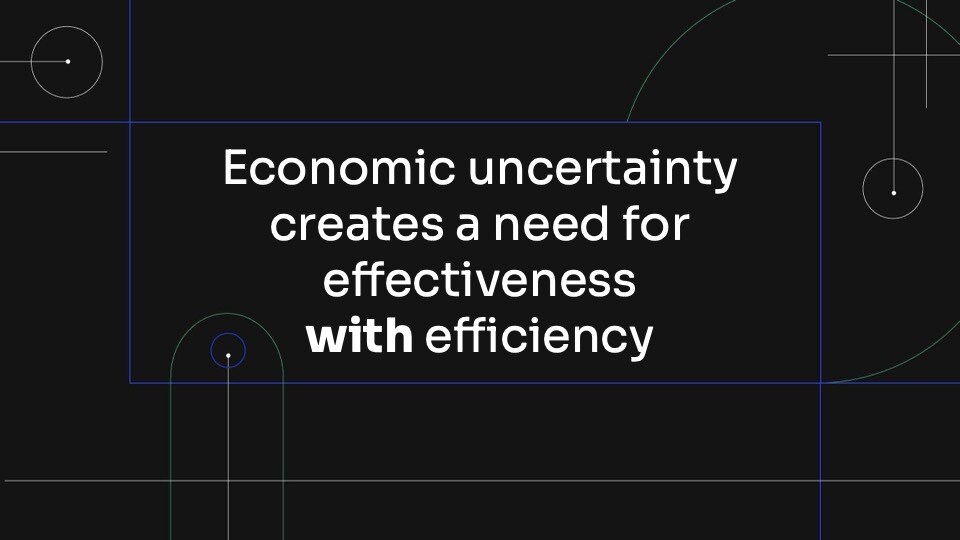The CMO’s Guide to Transforming GenAI from an Efficiency Tool to an Effectiveness Game-Changer
As we step into 2025, the marketing and advertising industry is undergoing an extraordinary transformation. AI is driving innovation, creative-first...
3 min read
 Rob Rakowitz
:
Apr 10, 2025 5:00:00 AM
Rob Rakowitz
:
Apr 10, 2025 5:00:00 AM

While we are just starting to see the fallout of the tariffs hit, a narrative is already starting to take shape in the advertising community on LinkedIn and in the industry trade press. A lot of the commentary reflects the simple nature of being able to control whatever you are able to, and suggests adjusting media investment and/or suggesting shifts in channels or buying methods.
But is a CMO really going to be concerned with just a tactical and technical shift in just one of their 5P’s? We are only just starting to see the investor shakeout of the tariffs and we have yet to see what the corporate response and the consumer shakeout will be.
Corporate marketers have been assessing this dynamic for months now already - the CFO has been driving a conversation on earnings protection, and the CMO has hopefully been looking at their options. The right conversation for the CMO to lead should be centered on driving effectiveness with efficiency.
Leading voices in marketing science and effectiveness - Les Binet, Byron Sharp, Mark Ritson - and firms like Ebiquity, IPA, and Kantar have all published work on marketing through uncertain economic times. Without a doubt company survival is the first priority, but brand growth and category leadership should not be abandoned just to satisfy cost management.
In the last recession we saw a lot of ‘trading down and trading out’ as the cornerstone of consumer behavior - and surely something that can’t be controlled by a marketer. However, there was a recent update to research by Ehrenberg-Bass in the Journal of Advertising Research (JAR) less than two years ago on this very topic and the results should be brought into each boardroom. The headline findings show that stopping ad spend will lead to a 10% market share loss per year. That’s a pretty bold headline to escape - and if you’re a marketer or an agency tasked with driving growth this academic evidence based research should be what you lead with.
But what do you follow up with, knowing that while you can stay ‘in market’ that what you stay ‘in market’ with should be examined?
Again going back to long-term marketing effectiveness analyses, we know that advertising creative effectiveness drives 60-70% of overall marketing investment impact. It’s on the higher end of that scale if you look at studies from Ehrenberg-Bass, the lower end if you look at studies from Google. That means that media is maybe 30% at best, yet most of the louder conversations we hear are in this much smaller area. As a longtime media leader - yes the flowchart and media buy should be scrutinized and optimized. But this is really only the efficiency the CMO is seeking.
So, what about effectiveness?
First, protect advertising investment that drives mass reach. This is fundamental to ‘laws of growth’ thinking. And as we know, mass reach looks very different nowadays, with digital platforms making up a significant part of the plan. And with digital platforms becoming an accepted part of the plan, there is valuable data to be mined there - creative data. Creative data is understanding how advertising performance and measurable elements in advertising creative are linked.
This is where the second step can be considered; advertisers and their agencies should scrutinize creative before it is flighted - has it performed and is it likely to perform? By looking at historical data, an advertiser can build this understanding quite quickly; in as little as 24 hours, a brand can determine if its creative adheres to publicly available platform best practices. Increasing adherence to best practices alone can unlock 30% lifts in advertising impact. In just 3 additional days, custom performance-based brand-specific guidelines can be uncovered. Adopting and adhering to custom best practices can turn over additional double digit lifts in increased advertising impact.
When we look at creative data and the recommendations put forth, it links back to some of these more irrefutable sources of marketing effectiveness. It encourages the identification and boosting of distinctive memory structures in creative executions. In a way these creative guidelines help corroborate the long-term thinking overall, and are a good complement on budgets. Consistency in a marketplace - certain or uncertain - is the key to brand growth.
Therefore, as budgets and marketing investment become scrutinized for their ROI, CMOs can actually go broader; they can go beyond the 30% potential impact of media optimization and look at the 70% of creative impact and optimize that area, and ideally in doing so make brands’ distinctive memory structures stronger.
Finally, this level of effectiveness can be delivered in new Gen AI tools; these data-driven rules can be integrated into creative Gen-AI platforms like Adobe and Canva. So now the route to effectiveness can be more efficient, and actually integrated into the creative development process. This cuts down creative timelines and pretesting significantly by a factor of 40% based on results we’ve been able to benchmark.
There’s a lot of noise around business tensions and marketing uncertainty. But what’s comforting is that marketing science encourages us to look at long term strategies, and beneath that the strength of brands. Marketers should look not at just efficiency but should instead prioritize effectiveness with efficiency. Creative data should be on marketers’ list of tools to consider. Creative data can assure marketers they are poised to unlock creative’s full potential - even in a challenging environment.

As we step into 2025, the marketing and advertising industry is undergoing an extraordinary transformation. AI is driving innovation, creative-first...

Anyone can throw a ton of money at a campaign and make conversions in the process, but knowing how to efficiently devote your most crucial resources...

In today’s ever-evolving landscape of digital marketing, understanding what drives successful campaigns has become increasingly complex. This is...